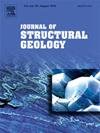Magnetic and microstructural perspectives on faulting in carbonate rocks, northern Israel
IF 2.9
2区 地球科学
Q2 GEOSCIENCES, MULTIDISCIPLINARY
引用次数: 0
Abstract
Shallow crustal faulting involves complex processes, including brittle and ductile deformation, frictional heating, and fluid interaction, which may all leave distinct geological signatures. However, deciphering these mechanisms is challenging. This study investigates the deformation near two faults in northern Israel: the active Nahef East fault and the Qiryat Shemona fault, a major strand of the Dead Sea Fault (DSF) system, both cutting through diamagnetic carbonate rocks. We employ a range of methods, including anisotropy of magnetic susceptibility (AMS), magnetic properties, electron backscatter diffraction (EBSD), and geochemical analyses to target specific faulting processes. Both faults exhibit magnetic fabrics with foliations formed by AMS maximum (K1) and intermediate (K2) axes which are scattered on a plane sub-parallel to fault surfaces, extending ∼0.5 m from these fault surfaces. In the Nahef East fault, slight changes in magnetic properties, overall mineralogy and microstructures such as lobate calcite grains, indicate moderate temperatures (<200-250 °C), and fluid interaction, which constrains grain reorientation and the development of crystallographic preferred orientation (CPO). Conversely, in the Qiryat Shemona fault, the small (∼5 μm) twinned calcite grains indicate moderate to high temperatures (>250–300 °C), high stress (≥100 MPa) and dry conditions, potentially reflecting the fault's maturity. Distinct deformation fabrics and microstructural features around these faults reveal localized plastic deformation. The results underscore a potential gap between the extent of deformation observed in natural faults and those replicated in laboratory experiments, likely due to limited sample size and timescale considerations in laboratory settings.
以色列北部碳酸盐岩断裂的磁学和微观构造观点
浅层地壳断裂涉及复杂的过程,包括脆性和韧性变形、摩擦加热和流体相互作用,这些过程都可能留下独特的地质特征。然而,破译这些机制是具有挑战性的。本研究调查了以色列北部两条断层附近的变形:活跃的Nahef东断层和死海断层(DSF)系统的主要分支Qiryat Shemona断层,这两条断层都穿过反磁性碳酸盐岩。我们采用了一系列的方法,包括磁化率各向异性(AMS)、磁性、电子背散射衍射(EBSD)和地球化学分析来针对特定的断层过程。这两个断层都表现出由AMS最大(K1)和中间(K2)轴形成的磁性结构,它们分散在与断层面平行的平面上,从这些断层面延伸约0.5 m。Nahef东断裂的磁性能、整体矿物学和方解石晶粒等微观结构的微小变化表明温度适中(200 ~ 250℃),流体相互作用限制了晶粒重定向和结晶学优先取向(CPO)的发育。相反,在Qiryat Shemona断裂中,小(~ 5 μm)孪晶方解石晶粒表明中高温(>250 ~ 300℃)、高应力(≥100 MPa)和干燥条件,可能反映了断层的成熟度。断裂周围明显的变形组构和微观结构特征揭示了局部塑性变形。结果强调了在自然断层中观测到的变形程度与在实验室实验中复制的变形程度之间的潜在差距,可能是由于实验室环境中样本量有限和时间尺度的考虑。
本文章由计算机程序翻译,如有差异,请以英文原文为准。
求助全文
约1分钟内获得全文
求助全文
来源期刊

Journal of Structural Geology
地学-地球科学综合
CiteScore
6.00
自引率
19.40%
发文量
192
审稿时长
15.7 weeks
期刊介绍:
The Journal of Structural Geology publishes process-oriented investigations about structural geology using appropriate combinations of analog and digital field data, seismic reflection data, satellite-derived data, geometric analysis, kinematic analysis, laboratory experiments, computer visualizations, and analogue or numerical modelling on all scales. Contributions are encouraged to draw perspectives from rheology, rock mechanics, geophysics,metamorphism, sedimentology, petroleum geology, economic geology, geodynamics, planetary geology, tectonics and neotectonics to provide a more powerful understanding of deformation processes and systems. Given the visual nature of the discipline, supplementary materials that portray the data and analysis in 3-D or quasi 3-D manners, including the use of videos, and/or graphical abstracts can significantly strengthen the impact of contributions.
 求助内容:
求助内容: 应助结果提醒方式:
应助结果提醒方式:


